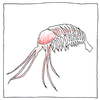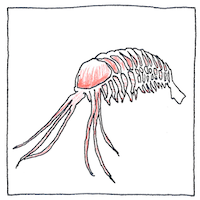Charles Doolittle Walcott
paleontology

|
Burgess shale
Charles Wolcott discovered in a shale outcropping on a steep mountainside of Mount Field in the Canadian Rockies fossils from five-hundred and five million years ago including impressions of soft body parts of previously unknown extinct animals.
Animals
Amiskwia, a soft-bodied invertebrate, had a rounded head with a pair of tentacles and a four-ganglion brain, a flexible body with rounded fins on the sides, and a paddle-shaped tail. Anomalocaris, meaning “abnormal shrimp,” was a large arthropod with compound eyes on two stalks with thirty thousand lenses. Canadaspis had claws on its front appendages and spines on its head to protect its eyes. It had numerous legs with gill flaps under them. Its body was protected by hinged clamshells; the end of its thick segmented tail had spines. Canadia, a spiny polychaete annelid worm, looked like a long feathery slug with a pair of tentacles or parapodia and it had a gut that it could extend out as a feeding proboscis. Choia was a demosponge like the barrel sponge with a flattened conical body stiffened with long spines. Hallucigenia, was an odd kind of wormy creature with seven pincer-tipped tentacles lined up on one side and seven pairs of jointed spines on the other, but with no obvious head or means of locomotion. Haplophrentis was a small conical shelled creature with a small shell closing the big end and leaving two gaps on each side from which protruded fleshy curved arms. Leanchoilia had two front arms ending in whip-like feelers. Its body was protected by a segmented shell like a pill bug. Marrella is a small animal whose head shield had two pairs of curved rearward blades protecting its body from above. Under its head were two pairs of antennae, one long and sweeping back, the second shorter and stouter. Its body had two dozen segments, each with a pair of branched appendages, the lower branches being legs and the upper branches feathery gills. Odontogriphus, meaning “toothed riddle,” was like a tongue with a circular mouth on its underside having rows of teeth. Opabinia had five eyes, a tubular feeding proboscis a fifteen-segmented body with side lobes, and a fan-shaped tail. Ottoia was a predatory carnivorous priapulid worm. Its eversible spiney proboscis protruded from its U-shaped burrow. Peytoia, also called Laggania, swam like a cuttlefish and had two mouth appendages with long bristle-like spines. Perspicaris had two large eyes and a forked tail; the two sides of its thorax were hinged at the top. Pikaia was a swimming eel-like finned-tail creature with pair of tentacles and gill slits on either side of its head. Thaumaptilon, meaning “wonderful soft feather,” was a leaf-shaped animal attached to the sea floor. Trilobite was a common three-lobed arthopod, with a cephalon or head shield, a thorax with seven jointed segments, and a semicircular pygium rump. Wolcott found the basic Olenoides serratus and two-lobed Naraoia compacta, which lacks a pygium. Wiwaxia was a small oval animal sheathed in small hard overlapping plates or scales and protected by short ribbed spines or bristles. Yohoia had a head shield and thirteen body plates followed by a paddle-like tail. Under its head were two long arms, each ending in four spines like little fingers, and three pairs of appendages that probably served as legs, and under its body plates were single flaps with fringes.
Interpretation
Interpreting the fossils of the Burgess Shale has continued. Were they evidence of a Cambrian explosion, the sudden appearance of multi-celled animals, defying Darwin and the orderly progress of evolution? Were they relatives of animals living today, such as branchiopods, crustaceans, echinoderms, and molluscs? Was Amiskwia an arrow worm, a ribbon worm, a mollusc, or an animal with no affinity to any living or extinct animal? Were the mouth, feeding appendages, and tail of Anomalocaris, discovered at first separately, separate creatures? Was Canadaspis a crustacean or an euarthropod? Did the spines of Choia radiate up and out for protection or were they laid out flat like the guy wires of a tent? Did Hallucigenia walk upon its spines, or did it slither in the mud on its belly? Was Haplophrentis a swimmer or a bottom feeder? Did Leanchoilia have two stalked compound eyes and two simple eyes, or did it have no eyes at all? Marrella was a primitive arthropod, but was it an early crustacean, scorpion, or trilobite? Was Odontogriphus the tongue of another creature? Was it an early mollusc, brachiopod, or worm? Were Opabinia’s gills set on top of its lobes or on special blades attached to the underside of its lobes? Was Ottoia a hunter, or did it wait for prey from its burrow? Walcott mistook Peytoia’s mouth for a jellyfish. Its feeding appendage and body were later found to be attached. Wolcott categorized Pikaia as a polychaete worm but others see it as a chordate or primitive vertebrate. Were Thaumaptilon sea pens, or colonial animals like corals? Thousands of spots on one of its sides could be separate creatures. Edward Lhwyd described a trilobite in 1698 as the skeleton of a flat fish. Charles Lyttleton in 1749 described it as a petrified insect. Manuel Mendez da Costa in 1754 said it was a marine louse. The Utes of North America called them little water bugs and wore them as amulets to ward off disease. Was Wiwaxia a polychaete, an annelid worm, or a primitive mullusc? To me, it looks like a simple sea urchin. Yohoia was shaped like a mantis shrimp but is thought to be an early horse-shoe crab or trilobite.



The tree of life on Earth is big and messy, suggesting it would not be improbable to find life on other planets.
The strangeness of the animals discovered in the Burgess Shale strained the efforts of many including Wolcott to force them into existing phyla. Today, scientists are more likely to create new phyla to accommodate these creatures. Many of these animals are arthropods, that is, invertebrates with exoskeletons.
See also in The book of science:
Readings in wikipedia:
Museum sites also describe numerous species found in Burgess Shale: